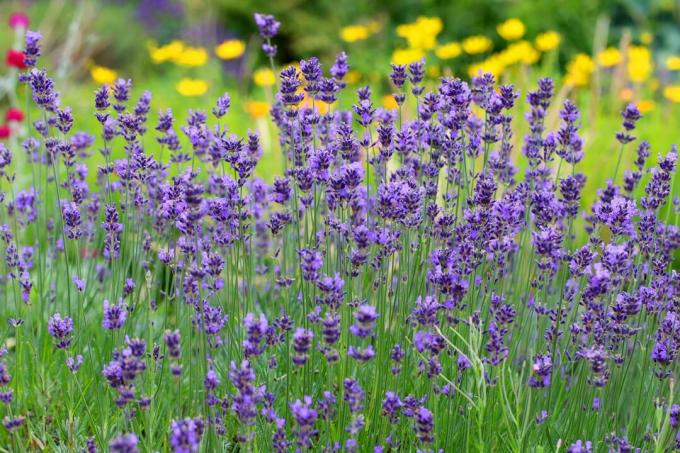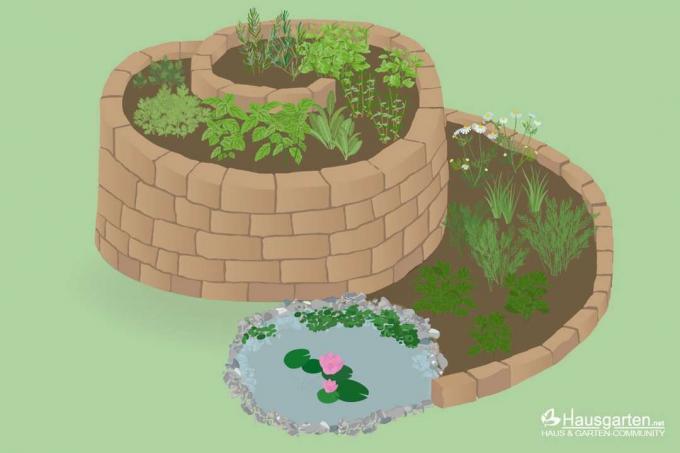

Table of contents
- Hardy thyme varieties
- Hardy thyme hybrid
- Overwinter in the bed
- Overwinter in a pot or tub
- Thyme in the bucket
- Thyme in a pot
- Care
- Overwinter in the house
Thyme is one of the easy-care kitchen herbs. If the location is sunny and the substrate is permeable, it can be kept in a herb bed or in a pot on the balcony or terrace. However, the cold, wet German winter is a problem for the Mediterranean herb, since thyme does not tolerate waterlogging at all and only tolerates frost to a limited extent. Therefore, you should protect thyme from rain, wind and frost in winter.
Hardy thyme varieties
When it comes to overwintering thyme, the first thing to ask is the variety, because there are a good 200 varieties within the thyme genus (botanically thymus). And some of them survive the German winter in the garden bed. The hardy varieties that survive all temperatures down to minus 20 degrees Celsius in the bed include:
- Common thyme (Thymus vulgaris)
- Upholstery thyme (Thymus doerfleri)
- Thyme (Thymus odratissimus)
- Cascade Thyme (Thymus longicaulis)
- Wild thyme (Thymus erpyllum)
Tip:
Only pure thyme varieties survive the cold season in the bed. When it comes to hybrids, caution is advised. Because they are not necessarily completely hardy.
Hardy thyme hybrid
Examples of hardy thyme hybrids include:
- Thymus vulgaris "Compactus"
- Thymus puledioides "coccineus"
- Thymus vulgaris "Tabor"
- Thymus puledioides "Orange Carpet" (common thyme)
Overwinter in the bed
Although the cold doesn't really bother the completely hardy thyme varieties, you should still take a few precautions for the cold season. Because the enemy of the thyme in the German winter is the wet. It is not well tolerated by the herb at all.
Tip:
Place the thyme slightly higher in the herb bed when planting it out. This allows rainwater to run off well in winter.

If it rains continuously, you should also protect completely hardy thyme. A good rain protection for the plants is to cover them with spruce or fir brushwood.
cold protection
In harsh locations or in persistent freezing cold, you should protect the planted thyme from the low temperatures as a precaution. Needle brushes or a breathable fleece are recommended here.
Care
In addition to protection from the wet and cold weather, you should also prepare the plants for the cold season with appropriate care measures:
- Stop fertilizing from mid-August
- do not cut back the plants from mid-August
These two care measures are intended to prevent the thyme from growing any fresh shoots trains, because these no longer mature until autumn and freeze to death even in autumnal ones cold snaps.
Overwinter in a pot or tub
If the pot thyme is to spend the winter on the balcony or terrace, the roots of the herb must be protected because they are helplessly exposed to the constant alternation of frost and thaw behind the thin wall of the planter are. This temperature change can rupture the cell walls in the tissues of the plants, resulting in the death of the plants. The options available for protection against temperature fluctuations and cold depend on the size of the planter.
Thyme in the bucket
If thyme is cultivated in a bucket, the bucket must be packed well to protect the roots. For planters with a diameter of more than 30 centimeters, you should take the following precautions:
- Pack the bucket tightly with bubble wrap
- Place the planter on a block of wood or on a styrofoam plate (against cold feet)
- Cover the substrate with wood shavings or needle brushwood
Tip:
Foliage is only partially suitable for covering the substrate, as it is not very permeable to air and can easily rot.
Since moisture is one of thyme's greatest enemies here, too, you should bring it to a location that protects the plants from rain. A south-facing house wall is ideal because it gives off additional heat.
Thyme in a pot

Packing many smaller pots individually is tedious and can also lead to space problems. That's why it's easiest if you let them overwinter in a wooden box. To do this, proceed as follows:
- Put pots in a wooden box
- Fill in the gaps with straw
- Place the box on a thick wooden board, a styrofoam plate or a piece of insulating mat (against cold feet)
- Cover wooden box with a mat of reed or coke fiber (insulates and looks nice)
- Tie the coat tightly with a rope
- Substrate with moisture-permeable material (eg. B. needlesticks) cover
- place the packed wooden box in a wind- and rain-protected location
Tip:
If the coat made of reeds or coconut fibers is a little higher than the wooden box, then the plants are also protected from the wind.
Care
Keep plants moderately moist throughout winter. Water if necessary on frost-free days. Only cut back next spring.
Overwinter in the house
Even if not all thyme varieties are completely hardy, they need a cool location in winter. For this reason, overwintering in heated living spaces is not ideal, as they are usually too warm and too dark.
Tip:
Smaller herb pots can move to bright, frost-free winter quarters in autumn. A conservatory is ideal. Alternatively, you can also place the pots on the windowsill in the kitchen.
 Home editorial office
Home editorial office
Learn more about growing herbs

Basil has black dots: what to do?
Especially basil bought in a pot from the supermarket tends to quickly develop black dots or spots on the leaves. This article explains why this is and what helps against it.

14 kitchen herbs that you can really keep in the kitchen
Sometimes a herb garden is only possible on the windowsill. If you don't have your own garden bed, for example, or in the months when the frost freezes the coveted greenery outside. Our list provides an overview of which herbs like the kitchen location permanently.

Parsley turns yellow: Four tips against yellow leaves
If the leaves of the parsley suddenly turn yellow, the so-called parsley disease is usually behind it. This can have many causes. If the outbreak of the disease is to be prevented, only prevention helps. More about this here.

You can combine lavender with these 13 plants
Whether you use it in the kitchen, want to enjoy its fragrance or its beauty, lavender is a must in any garden. Well combined, it can strengthen other plants or protect them from pests. We present the best plant neighbors.

8 tips for cutting and harvesting herbs properly
Fresh herbs from the garden should not be missing in any kitchen. They are versatile, exude pleasant and spicy scents and are a treat for the eye with their pretty flowers. In the kitchen, they can easily replace artificial flavor enhancers.

Herb spiral & herb snail: this is how it's done
A herb spiral or herb snail makes it possible to plant many different varieties in a particularly decorative way. However, this is not the only advantage of these variants of the culture. You can find out how to create them here.


